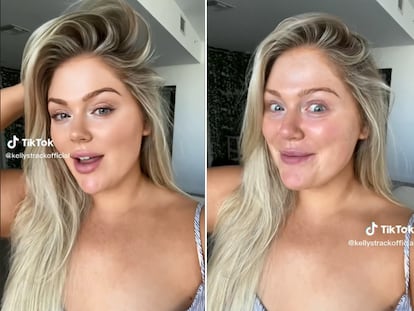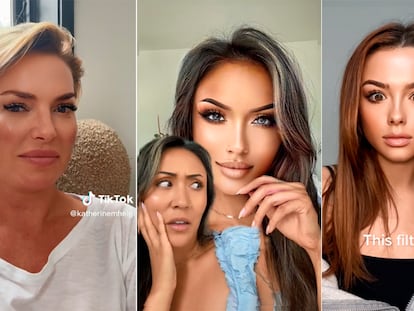Cyborg chic: Welcome to the era of transhuman beauty
In the exploration of the possibilities beyond corporeality, algorithms homogenize taste and the technological gaze standardizes faces
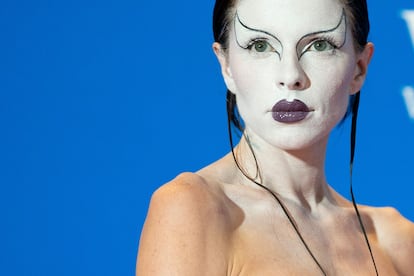
Angular profile, wide forehead, large, slightly spaced eyes, high cheekbones, the nose as sharp as the chin, full lips and cold, pristine skin, like metal. This is what Bella Hadid looked like on the May cover of Vogue Italia magazine. An image in which the only real thing was the model. The scene around her had been conceived by artificial intelligence. What the magazine did not mention was that Hadid’s own face, flesh and blood notwithstanding, had also been previously designed and edited. As have those of other popular figures such as Hailey Bieber or Amelia Gray Hamlin, famous for being ahead of the curve when it comes to eyebrow bleaching. Faces that have been evolving in recent years, with surgeries or makeup, until boasting a disturbing beauty reminiscent of a cyborg, a half-human, half-machine creature.

The body has always been a medium on which to represent belief systems and aesthetic tastes and, as such, it is prone to mutation. The history of painting is a good reflection of this: “Beauty is a changing language,” says art historian and author of 100,000 Years of Beauty, Elizabeth Azoulay. “Let’s take the Mona Lisa as an example. When Da Vinci painted her, she had eyelashes and eyebrows, but several decades later an anonymous painter erased them. Taste had changed and the idea that all hair had to be removed prevailed; humans were God’s chosen creatures, not furry animals.” Thus, Mona Lisa lost her eyebrows, several centuries ahead of others like Gray Hamlin, Rosalía or Madonna — even if today’s muses draw more from avatars and humanoids than from divine inspirations.

Cyborgs are not new on the runway. Alexander McQueen, a pioneer in so many things, played with the possibilities of combining body and machine in many of his collections. Already in 1999 he closed his winter show for Givenchy with a model who only wore white pants and a sort of transparent armor covered by cables and lights that went all the way up to her shaved head. The exploration of the possibilities beyond corporeality is a path in which artists of all kinds have been interested; transhuman specimens have served as unifying thread for women’s collections by Comme des Garçons, Rick Owens and Gucci. Creatures close to those described in 1984 by Donna Haraway in A Cyborg Manifesto: “A cybernetic organism, a hybrid of machine and organism, a creature of social reality as well as a creature of fiction,” she wrote. “The cyborg is resolutely committed to partiality, irony, intimacy, and perversity. It is oppositional, utopian, and completely without innocence.” She imagined that women could become fluid, radical, resistant beings, disloyal to the self-image that they had not chosen.
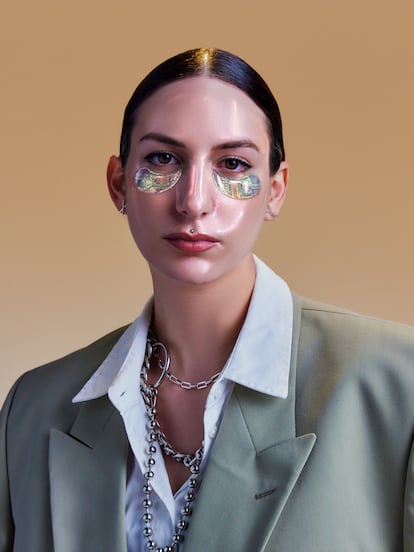
However, today’s cyborg is far removed from the ideas put forward by the feminist. It is not so much about vindication as it is about the imposition of a panorama that, like Hadid’s cover, is shaped through image generation programs and enforced by algorithms (mostly created by men) that seek to engage. From Instagram filters to apps like Lensa or Midjourney. Even Zoom video calls can now be edited. Thus, the aesthetic aspiration is distorted, seeking to replicate the effects of technology. Beauty industry journalist Jessica DeFino explains it in her newsletter: “Highlighting is an excellent example of how machinery informs modern appearance ideals: the technique doesn’t recreate an innate human feature but rather, the effects of heavy-duty Hollywood lighting equipment.” She also condemns how the goal is less and less human — a “cyborg skin” that seeks “to flatten any and all signs of life (wrinkles, pimples, pores).” There is no easy escape.
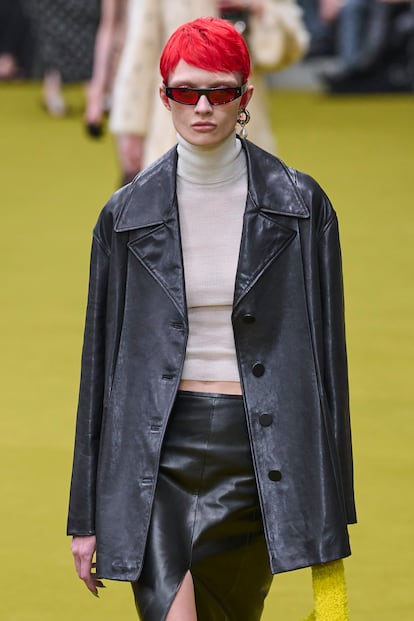
“What, actually, is ‘the face’?” pondered the German historian Hans Belting in his book Face and Mask. “It does not truly become a face until it interacts with other faces, seeing or being seen by them.” In 2023, that equals a pixel bomb. Faces as the basis of the content that is consumed every day on our phone’s screen, on social media. An ecosystem in which nothing is innocent and everything can be monetized, denounces Elise Hu, author of Flawless: Lessons in Looks and Culture from the K-Beauty Capital: “In Korea, we see how the long-established heteronormative notion that women chase beauty to appeal to the male gaze can be overshadowed by something more complicated: a technological gaze,” she writes. “This gaze is an algorithmically determined set of ideal traits for our facial and body parts that social platforms feed us through the content we scroll. It represents a power shift from an external, male-judging gaze to a self-policing narcissistic gaze […], the self-policing tech gaze creates demand for what we should look like and also feeds it.”
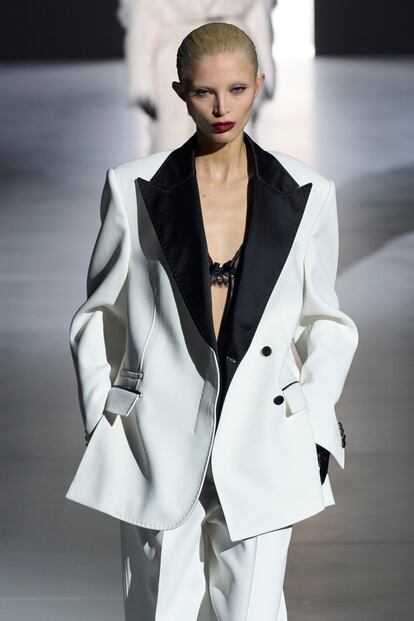
If Da Vinci painted the prototypical proportions in his Vitruvian Man, in Korea aesthetic clinics are already using codes that analyze the most liked faces in order to recommend optimized procedures for their clients. Because thanks to the technological improvements, these body updates are becoming increasingly easier. Injectable procedures, among the least intrusive, are some of the most popular. You can even modify a nose with them now. Still, it is advisable not to trivialize them, warns plastic surgeon Isabel de Benito: “They are affordable, but they are not easy. They should be left in the hands of experts.”

The infinite alternatives offered by cosmetics, surgery and filters, open the door to an infinite range of possibilities to define identities. Digital artists like Johanna Jaskowska or Ines Alpha (whom Prada just hired for the launch of its makeup line) are proof of this. Meanwhile, a revolution against the system will involve renouncing the perfect divinity and embracing the difference, be it human or humanoid. “I would rather be a cyborg than a goddess,” wrote Haraway.
Sign up for our weekly newsletter to get more English-language news coverage from EL PAÍS USA Edition
Tu suscripción se está usando en otro dispositivo
¿Quieres añadir otro usuario a tu suscripción?
Si continúas leyendo en este dispositivo, no se podrá leer en el otro.
FlechaTu suscripción se está usando en otro dispositivo y solo puedes acceder a EL PAÍS desde un dispositivo a la vez.
Si quieres compartir tu cuenta, cambia tu suscripción a la modalidad Premium, así podrás añadir otro usuario. Cada uno accederá con su propia cuenta de email, lo que os permitirá personalizar vuestra experiencia en EL PAÍS.
¿Tienes una suscripción de empresa? Accede aquí para contratar más cuentas.
En el caso de no saber quién está usando tu cuenta, te recomendamos cambiar tu contraseña aquí.
Si decides continuar compartiendo tu cuenta, este mensaje se mostrará en tu dispositivo y en el de la otra persona que está usando tu cuenta de forma indefinida, afectando a tu experiencia de lectura. Puedes consultar aquí los términos y condiciones de la suscripción digital.
More information
Archived In
Últimas noticias
David Bowie, the galactic thinker who encouraged us to break new ground
John Berger and the loss of rural culture
From police officer to bloodthirsty kidnapper: Terror in Mexico during the years of ‘The Ear Chopper’
Alain Aspect, Nobel laureate in physics: ‘Einstein was so smart that he would have had to recognize quantum entanglement’
Most viewed
- David King, chemist: ‘There are scientists studying how to cool the planet; nobody should stop these experiments from happening’
- Reinhard Genzel, Nobel laureate in physics: ‘One-minute videos will never give you the truth’
- Oona Chaplin: ‘I told James Cameron that I was living in a treehouse and starting a permaculture project with a friend’
- Mexico completes its trade shift with the entry into force of tariffs on China and countries without trade agreements
- Sinaloa Cartel war is taking its toll on Los Chapitos

